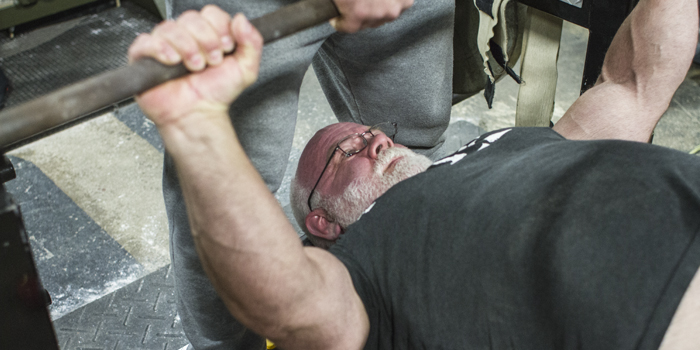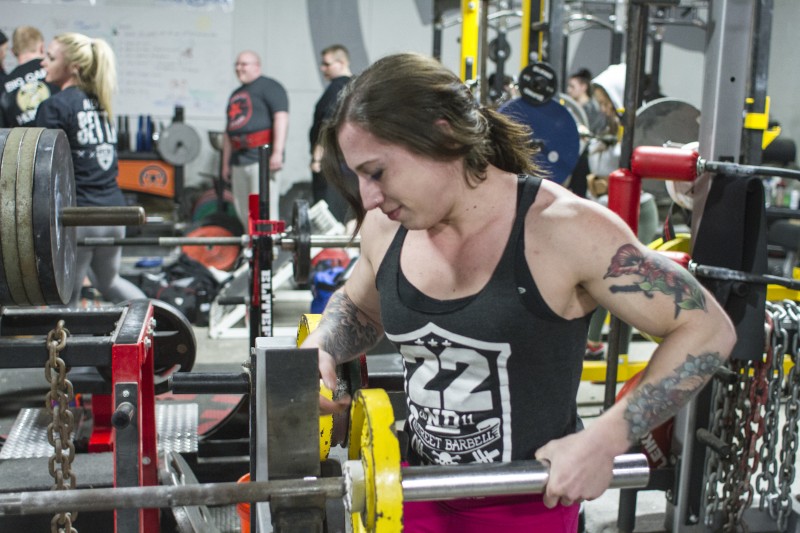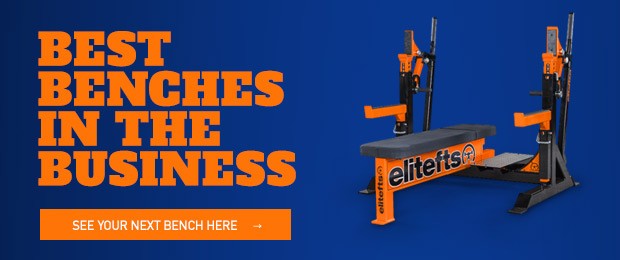
If you want to add major pounds to your bench in just nine short weeks and push some heavy weights, you’re reading the right article! The following benching cycle is something I have used multiple times myself and with great success with my lifters. In the following nine weeks you will learn to bench smarter, utilize proper technique, and move some heavy-ass weights.
Benching is a skill. To get good at benching, you need to practice benching. You might have heard the expression “practice how you play.” Well, this holds true for bench pressing, too. I see most people struggle to make progress because they overcomplicate things! Keep your bench program simple. All most people need to make progress in the bench is a simple program that continues to push you each week, a competitive drive to better yourself, and the willpower to see it out to the end.
WATCH: Table Talk — Training Tips to Break a Bench Press Plateau
I see lifters changing so many variables in their benching that they probably forgot how to competition bench with a regular bar. How often do you see lifters using a Football Bar one week, floor pressing with a Duffalo Bar the next week, adding chains to a Swiss Press Bar the next week, feet up close grip the next, and the list goes on and on? Don’t get me wrong, variation is key for building up weak points and keeping the stimulus changing. These exercises, however, are better suited as secondary movements after you have already completed your main bench sets of the session.
The following cycle I’m about to lay out for you is a very simple linear progression. There is no magic to it; this type of training has been around since the very beginning. You’re starting with a higher volume phase, in this case, five sets of five. Each week you’re increasing the percentages you’ll be working with. These percentages are all based off your one rep max minus five to 10 pounds to ensure good technique.
This is your first benching day of the week. In this program, we’ll be benching two times a week. This day is best done on a Sunday, Tuesday, or whenever you consider the beginning of your training week. For myself and many of my lifters, I would have them squat on Monday and do this bench cycle on a Tuesday. The cycle looks like this:
First Benching Day of the Week
Example: Lifter's One-Rep Max = 355
Minus 10 Pounds For Training Max = 345
We will be basing percentages off this lifters training max of 345 pounds. The reduction of 10 pounds ensures the lifter is able to maintain good technique while using these percentages.
- Week 1 — 5x5 (70%, 75%, 80%) (2x240, 2x260, 1x275)
- Week 2 — 5x5 (73%, 77%, 82%) (2x250, 2x265, 1x280)
- Week 3 — 5x5 (75%, 80%, 85%) (2x260, 2x275, 1x295)
- Week 4 — 5x3 (77%, 82%, 85%) (2x265, 2x280, 1x295)
- Week 5 — 5x3 (80%, 83%, 87%) (2x275, 2x285, 1x300)
- Week 6 — 5x3 (83%, 87%, 90%) (2x285, 2x300, 1x310)
- Week 7 — 5x1 (87%, 90%, 92%) (2x300, 2x310, 1x315)
- Week 8 — 5x1 (90%, 92%, 94%) (2x310, 2x315, 1x325)
- Week 9 — 5x1 (92%, 94%, 97%) (2x315, 2x325, 1x335)
Why This Works
This cycle is all about practice: using manageable weights that allow you to practice bench pressing with good form. The biggest issue I see with people trying to improve their bench press is using too much weight. Many are under the impression that if the weight isn't heavy enough and they aren’t close to failing that they won’t get a good training benefit. It is quite the opposite. Using too much weight doesn’t allow you to make changes to technique. You spend most the time grinding out reps with poor form rather than moving the bar perfectly with great form.
I often tell lifters that hitting a smooth set of four reps knowing that you had one rep left in the tank is better than grinding out five reps. Just because you can doesn't mean you should. End sets when you feel your technique is failing. Once that bar path gets funky and you start fatiguing, only negative training effects can occur.
This simple linear cycle is awesome because, for the majority of it, you are handling weight that should be manageable. You really shouldn’t encounter a week where you fail a rep. By the end of the cycle, you’ll find that weight that once felt heavy, you’re now moving effortlessly and without form breakdown. On that ninth week, when you’re lifting 97% of your training max, you should feel like you’re capable of lifting over your previous max. Like I mentioned, feeling like you can is just as good as doing when it comes to training. Save the big lifts for the platform.
The next cycle I’m about to present to you is your second benching day of the week. For myself and my lifters, this day usually falls on a Friday after benching Tuesday. This cycle serves a much different purpose in the training. Each day compliments each other well, as I’ll explain.
Second Benching Day
Example: Same Lifter's One-Rep Max = 355
Minus 10 Pounds For Training Max = 345
- Week 1 — (-5% 1RM) Three-Board, (1RM) Three-Board, (+5% 1RM) Three-Board (1x330, 1x345, 1x360)
- Week 2 — (-5% 1RM) Two-Board, (1RM) Two-Board, (+5% 1RM) Two-Board (1x330, 1x345, 1x360)
- Week 3 — (-5% 1RM) One-Board, (1RM) One-Board, (+5% 1RM) One-Board (1x330, 1x345, 1x360)
- Week 4 — (1RM) Three-Board, (+5% 1RM) Three-Board, (+10% 1RM) Three-Board (1x345, 1x360, 1x380)
- Week 5 — (1RM) Two-Board, (+5% 1RM) Two-Board, (+10% 1RM) Two-Board (1x345, 1x360, 1x380)
- Week 6 — (1RM) One-Board, (+5% 1RM) One-Board, (+10% 1RM) One-Board (1x345, 1x360, 1x380)
- Week 7 — (+5% 1RM) Three-Board, (+10% 1RM) Three-Board, (+13% 1RM) Three-Board (1x360, 1x380, 1x390)
- Week 8 — (+5% 1RM) Two-Board, (+10% 1RM) Two-Board, (+13% 1RM) Two-Board (1x360, 1x380, 1x390)
- Week 9 — (+5% 1RM) One-Board, (+10% 1RM) One-Board, (+13% 1RM) One-Board (1x360, 1x380, 1x390)
Why This Works
The boards are an awesome tool to utilize to make you a stronger bencher. They are not only for equipped benchers but are equally as great for raw lifters. I stumbled upon using more boards with my raw guys as an alternative to the Slingshot. Don’t get me wrong, the Slingshot is a great product and I still use it in my programming, but in terms of preparing raw guys to peak, I found the boards have a better carryover.
The reason for this is that the Slingshot tends to change a raw lifter's bench groove too much. To get a good carryover and maximize the Slingshot you need to bench a little more like an equipped lifter and less like a raw lifter. However, with boards, you can keep your same bench groove and handle similar weights that you would in a Slingshot.
I digress, back to why this board cycle makes you stronger. The boards allow you to get that overload. What I mean by “overload” is that you are handling more weight than your body is capable of handling through a full range of motion. This comes as a great shock to the muscles and, most of all, to the nervous system. The nervous system now has to make sure all your muscles are firing full force and in unison to handle this supra-maximal weight. I’m forewarning you now that when you go back to handling weight on the first cycle the weight is going to feel super light.
The boards also teach you how to brace correctly. If you can’t control your body on the bench then this will teach you how to do it pretty damn quickly. This is what makes this cycle so effective for a beginner as well. Many beginners need to have that heavy weight in their hands to learn how to control it. If you can control and move 50 pounds over your current max then I’m willing to bet you can control sub-maximal weights pretty well. Heavy weights expose weakness and force you to adapt.
Also as I alluded to earlier, unlike with the Slingshot, the boards allow you to overload without changing your bench groove. This is a critical aspect. The first cycle is all about perfecting your bench groove; why do something that will potentially confuse your body? You need to learn patterning with the bar. I tell lifters to practice hitting the exact same spot on their chest each and every rep and maintain the exact same bar path. The boards allow you to do this! In fact, they help teach you to do this because you can’t misgroove heavy weight like that and finish the lift. Make sure you have spotters around!
Board Options
Lifters who haven’t utilized boards may be wondering, “What’s a board and how can I do this without training partners?” There are a lot of great options out there now for board pressing. My favorite is the standard wooden boards; I have bought all of mine from elitefts.com. I like to be able to follow the bar with my eyes down to the board, especially if benching in a shirt. The only downside is that you need someone to hold the board on top of also having a hand-off guy.
Elitefts also makes shoulder-saver pads. These pads attach right onto the bar so you don’t need anyone to hold the board on your chest. The best part about them is that they are round, so a smooth chest touch is always guaranteed. Often times the pad tends to roll a bit but with the round pad it is not a concern. They have them in two-board and one-and-a-half-board options.
One of your best all-purpose options is Bench Blokz. Bench Blokz also attach onto the bar so a board holder is eliminated. Bench Blokz make an easily attachable two to five-board option and an additional half to one-board option. These two options cover all of your board heights. The only downside to the Bench Blokz is the rectangular shape, which can sometimes, but not always, turn on you when repping out.
Word of Advice
Using these two cycles together is a great template that I guarantee will make you a stronger bencher. They feed into each other very well and train different aspects of bench pressing. This nine-week program covers your main sets only. You need to do more training than this to see the best results. This is where secondary movements and accessory movements come in. Training a triceps-dominant bench press, or a lockout range bench press, then performing movements to train arms, shoulders, back, etc., is how you’ll see drastic results.
My advice on that end is to find where exactly in the bench press you struggle. Is it keeping tightness on the chest? The transition off the chest? Can’t seem to lock out the end range of the press? Whatever it may be, select exercises that will build up your weakness. For example, one of my favorite triceps bench builders is the two-board, close grip, feet-up bench press. This movement gasses your triceps and will definitely add some pop to your competition bench. Find things you suck at and make them better.
Board work can be extremely taxing on the body and the joints. If you’re an advanced lifter handling very heavy weight or your recovery is not up to par then you’re going to need to deload. When you start to feel especially fatigued and beat up it’s best to take a week off from board pressing. The best time to do this is after a one-board week before working back up in the boards. This is an opportune time to chill out a bit and let your body recover. I’ve had to do it and I’ve had to do it with my athletes. It doesn’t mean you’re not following the program and you won't get results; it’s just the smart thing to do that will keep you healthy long-term to get the results you’d like.
Board work and smart benching is what has allowed me to bench over 600 pounds multiple times in competition and bench 585 at a bodyweight of 198. This stuff works, and I encourage you to give it a shot and get your friends to join on as well. My goal is to build stronger bench pressers worldwide.
My website www.bigbenchas.com and my YouTube channel Big Benchas is dedicated to providing all the content you need to take your bench to the next level. I cover every aspect of how to perfect the technical side of bench pressing. I encourage you all to reach out to me for additional training help. You can reach me at coachben@bigbenchas.com.











What rep range do you prefer for the close grip 2 board press you mentioned for accessory work?
Week 1 — 5x5 (70%, 75%, 80%) (2x240, 2x260, 1x275)
What does the 5x5 correspond to? Typically 5 sets of 5 reps but it seems you’re suggesting 3 set of 2 reps?
Thanks
Tim
The rep scheme in question is indeed 5x5, with 2x5 at 240, 2x5 at 260 and 1x5 at 275. This totals 5 working sets.
The numbers within the brackets indicate the sets used with each respective weight.
Hope this helps!